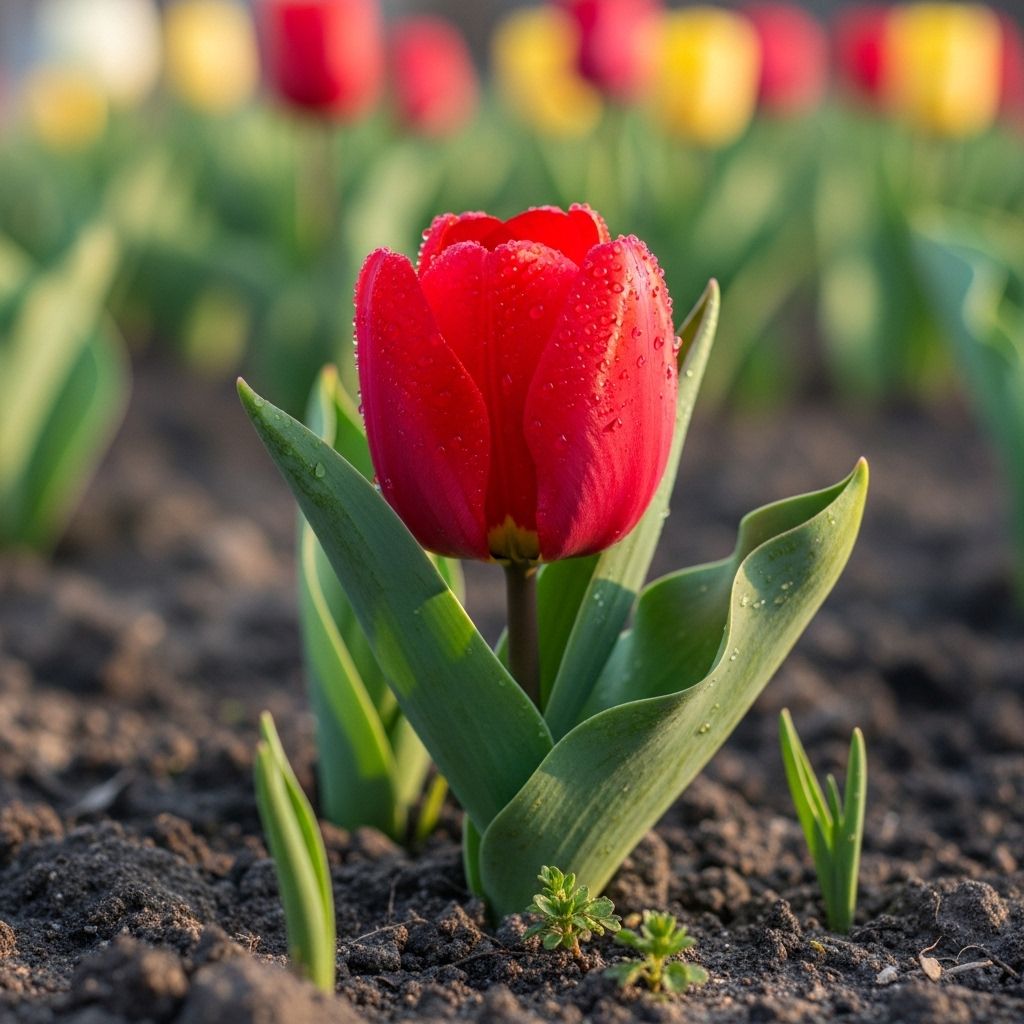How To Grow Tulips: Comprehensive Planting, Care & Design Guide
Explore planting, care, and design tips for vibrant tulips in your garden landscape.

Image: HearthJunction Design Team
Tulip Guide: Planting, Care, Varieties, and Garden Design
Basics
Tulips are iconic spring flowers, renowned for their vivid colors and graceful shapes. Easily grown in borders, beds, or containers, tulips are a staple for many gardeners who eagerly anticipate their annual display.
Climate and Zones
Tulips thrive in USDA Hardiness Zones 3 to 8. They require a period of cold dormancy, needing 14 to 15 weeks of winter temperatures below 48°F to perform their best. Ideal spring conditions for tulips include long, mild seasons with temperatures ranging from 45 to 60°F.
Height and Bloom Time
Tulips vary in height from just 6 inches to as tall as 24 inches, depending on the variety. They bloom from early to late spring, with exact timing depending on the specific type or cultivar.
Exposure and Flower Colors
Tulips require full sun to thrive, although they will grow before most deciduous trees have leafed out. In shade, flower stalks may become weak and spindly, producing small flowers. Tulips come in a large array of single and multi-colored varieties. Popular colors include pink, white, red, orange, purple, and yellow.
Types of Tulips
There are many different types of tulips, each with unique shapes, colors, and bloom times. Here are some of the most popular categories:
- Single Early Tulips: Bloom early in the season, with cup-shaped flowers.
- Double Early Tulips: Have multiple layers of petals, resembling peonies, and bloom early.
- Triumph Tulips: Reliable, classic tulip shape, blooming mid-season.
- Darwin Hybrid Tulips: Tall, sturdy stems and large blooms, excellent for cut flowers.
- Lily-Flowered Tulips: Elegant, pointed petals for a unique look.
- Fringed Tulips: Petals with fringed edges, adding texture.
- Viridiflora Tulips: Petals with green streaks, creating striking patterns.
- Rembrandt Tulips: Historic varieties with colorful streaks and patterns.
- Parrot Tulips: Ruffled, flamboyant petals in bold colors.
- Species Tulips: Wild or botanical types, often smaller and more natural in appearance.
Planting Tulips
When to Plant Tulip Bulbs
Plant tulip bulbs in the fall, ideally when nighttime temperatures are consistently between 40 and 55°F, and about 6 to 8 weeks before a hard, ground-freezing frost is expected. This gives the bulbs enough time to establish roots before winter begins.
How to Plant Tulip Bulbs
Follow these steps for successful tulip planting:
- Choose a site with full sun and well-drained soil. Avoid areas where water collects.
- Loosen the soil to a depth of at least 12 inches and incorporate compost or organic matter for improved drainage and fertility.
- Plant bulbs with the pointed end up, at a depth of about 2 to 3 times the height of the bulb (usually 6 to 8 inches deep).
- Space bulbs 4 to 6 inches apart.
- Water thoroughly after planting to settle the soil and encourage root growth.
Planting Tulips in Containers or Beds
Tulips adapt well to both garden beds and containers. For containers, use a high-quality potting mix and ensure there are drainage holes. In beds, mass plantings or borders create the most dramatic effect.
Tulip Care
Watering
Water tulips after planting and during dry periods in the fall and spring. Overwatering or waterlogged soil can cause bulbs to rot.
Fertilizing
Apply a slow-release bulb fertilizer at planting time and again as shoots emerge in the spring. Avoid high-nitrogen fertilizers, which can encourage foliage at the expense of flowers.
Mulching
Mulch lightly with straw or shredded leaves after planting to help maintain soil moisture and moderate temperature fluctuations.
Deadheading and Foliage Care
Remove spent flowers to prevent seed formation and encourage the plant to store energy in the bulb. Allow the foliage to die back naturally after blooming before removing it. This process replenishes the bulb for next year’s growth.
Tulip Varieties
There are thousands of tulip varieties, each with unique features. Here are a few notable ones:
| Name | Bloom Time | Height | Color | Special Features |
|---|---|---|---|---|
| Red Impression (Darwin Hybrid) | Mid-spring | 20–24 in | Red | Large, classic bloom |
| Angelique (Double Late) | Late spring | 14–18 in | Pink | Peony-like, fragrant |
| Purple Prince (Lily-flowered) | Late spring | 18–22 in | Purple | Pointed, elegant petals |
| Spring Green (Viridiflora) | Late spring | 16–20 in | White with green | Unique green streaks |
| Princess Irene (Triumph) | Mid-spring | 14–16 in | Orange with purple | Colorful, compact |
Using Tulips in the Garden
Garden Design Ideas
There are many ways to incorporate tulips into your garden design for maximum impact:
- Formal Rows: Plant tulips in neat, evenly spaced rows for a structured look. Use contrasting colors for visual interest, such as alternating red and white tulips.
- Naturalistic Drifts: Mimic nature by planting tulips in informal, sweeping drifts or clusters. Group bulbs in clusters of three to seven, varying spacing for a natural effect.
- Mixed Borders: Combine tulips with other spring-flowering plants, such as daffodils, hyacinths, or perennials. Place tulips at the front of the border for maximum visibility, with taller plants behind.
- Containers: Tulips are excellent for pots and window boxes. Mix different colors and types for a vibrant display, or pair with spring annuals like pansies.
Companion Plants
Good companion plants for tulips include:
- Daffodils
- Hyacinths
- Pansies
- Forget-me-nots
- Ornamental grasses
- Foxgloves (for taller backgrounds)
Tulip FAQs
Q: When is the best time to plant tulips?
A: The best time to plant tulips is in the fall, 6 to 8 weeks before the ground freezes, typically when nighttime temperatures are between 40 and 55°F.
Q: How deep should I plant tulip bulbs?
A: Plant tulip bulbs 2 to 3 times their height deep, usually about 6 to 8 inches, with the pointed end up.
Q: Can tulips grow in containers?
A: Yes, tulips grow well in containers as long as you use well-draining soil and ensure the pot has drainage holes.
Q: Why are my tulip flowers small or don’t open well?
A: Small or poorly opening flowers may result from insufficient sunlight, poor drainage, or overly warm winter temperatures (lack of cold period).
Q: Should I cut the foliage after tulips bloom?
A: No, leave the foliage until it has yellowed and died back naturally. This allows the bulb to store energy for next year’s growth.
Q: Will tulips come back every year?
A: While some tulip varieties will naturalize and return year after year, many hybrid tulips are best treated as annuals, especially in warmer climates or where summers are hot and wet.
Q: What are the best companion plants for tulips?
A: Daffodils, hyacinths, pansies, and forget-me-nots make great companions for tulips, providing color and interest throughout the spring.
Conclusion
Tulips are a garden favorite, offering a dazzling array of colors and forms each spring. Whether planted in formal rows, naturalistic drifts, or mixed borders, tulips add beauty and excitement to any landscape. By following proper planting and care techniques—such as planting in fall, providing full sun and well-drained soil, and selecting the right companion plants—you can enjoy vibrant tulip displays year after year.
Pictures
Explore our gallery for inspiring tulip garden designs and to see examples of different tulip varieties in bloom.
Garden Ideas
Get creative with your tulip garden by experimenting with color combinations, planting patterns, and companion plants. Formal, naturalistic, and mixed border designs all offer unique ways to showcase tulips in your outdoor space.
References
- https://www.gardendesign.com/bulbs/tulips.html
- https://bloominglucky.com/tulip-gardening-my-plans-and-favourites/
- https://kellogggarden.com/blog/gardening/gardeners-guide-to-planting-tulips/
- https://www.almanac.com/plant/tulips
- https://www.bloomsybox.com/blog/posts/designing-a-tulip-garden-tips-for-a-stunning-landscape
Read full bio of Anjali Sayee












